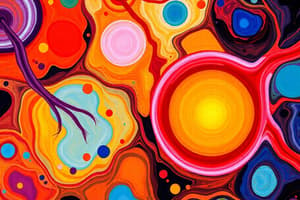Podcast
Questions and Answers
What is a significant characteristic of oogenesis compared to spermatogenesis?
What is a significant characteristic of oogenesis compared to spermatogenesis?
- Oogenesis produces sperm continuously.
- Oogenesis happens in the seminiferous tubules.
- Oogenesis occurs throughout life.
- Oogenesis results in a limited number of eggs. (correct)
How many primary oocytes are present at birth in females?
How many primary oocytes are present at birth in females?
- 40,000
- 400
- 2 million
- 200 million (correct)
What is the outcome when a mature spermatozoa meets an ovulated egg?
What is the outcome when a mature spermatozoa meets an ovulated egg?
- Fertilization occurs. (correct)
- The egg undergoes mitosis.
- A new sperm is formed.
- No interaction happens.
What happens to the chromosome number during meiotic division?
What happens to the chromosome number during meiotic division?
What is a key characteristic of spermatogenesis?
What is a key characteristic of spermatogenesis?
What ultimately occurs if meiotic division doesn't happen in gametogenesis?
What ultimately occurs if meiotic division doesn't happen in gametogenesis?
Why are there only a limited number of oocytes that survive until ovulation?
Why are there only a limited number of oocytes that survive until ovulation?
What is true about the chromosomes contributed by the parents to the fetus?
What is true about the chromosomes contributed by the parents to the fetus?
What substance is primarily responsible for depolymerizing hyaluronic acid polymers in the intercellular cement?
What substance is primarily responsible for depolymerizing hyaluronic acid polymers in the intercellular cement?
Which environment is considered hostile to sperm during fertilization?
Which environment is considered hostile to sperm during fertilization?
What structure encapsulates the egg and presents a barrier for sperm penetration?
What structure encapsulates the egg and presents a barrier for sperm penetration?
What component of the sperm enters the egg during fertilization?
What component of the sperm enters the egg during fertilization?
Where do the majority of mitochondria in a fetus originate from?
Where do the majority of mitochondria in a fetus originate from?
What role do the cilia in the fallopian tube play during fertilization?
What role do the cilia in the fallopian tube play during fertilization?
What happens to the sperm's mitochondria during fertilization?
What happens to the sperm's mitochondria during fertilization?
What is one of the functions of the cervical mucus in relation to sperm?
What is one of the functions of the cervical mucus in relation to sperm?
Study Notes
Gametogenesis
- Fetus presents unique foreign antigens, with chromosomes split equally from mother and father.
- Oogenesis and spermatogenesis are the two main processes of gametogenesis.
Oogenesis
- Starts with 200 million primary oocytes developed during fetal growth.
- Only about 40,000 oocytes survive until puberty.
- Each menstrual cycle, only one oocyte is ovulated and capable of fertilization.
- Aging processes in females directly correlate with the age of their oocytes.
Spermatogenesis
- Males have the capacity to produce spermatozoa throughout their life.
- Sperm development initiates in the seminiferous tubules of the testes.
- Sperm production occurs in stages organized spatially and temporally within the testes.
- Males maintain a reserve of sperm which replenishes after each ejaculation.
Fertilization
- Sperm has to travel from the vagina to the fallopian tubes for fertilization.
- The fallopian tube captures the egg using its fimbrae and contains ciliated epithelium to aid in movement.
- The vagina presents a hostile environment for sperm due to acidity and bacteria that may hinder survival.
- The cervix serves as a mechanical and chemical barrier to sperm, typically closed by a mucus plug.
- Zona Pellucida is a thick protective layer around the egg, complicating sperm penetration.
- During fertilization, only the sperm nucleus enters the egg, reestablishing the diploid number of chromosomes (2n or 46).
- Sperm's tail and neck, which contain mitochondria, do not enter the egg; thus, mitochondrial DNA is predominantly inherited from the mother.
Implications of Fertilization
- Mitochondrial DNA from the sperm is minimal, leading to maternal inheritance.
- This mechanism emphasizes the selective nature of fertilization, facilitating genetic continuity across generations.
Studying That Suits You
Use AI to generate personalized quizzes and flashcards to suit your learning preferences.
Description
Test your knowledge on the processes of gametogenesis, including oogenesis and spermatogenesis. Explore the intricacies of how eggs and sperm develop and the mechanisms behind fertilization. This quiz covers essential concepts relevant to reproductive biology.




